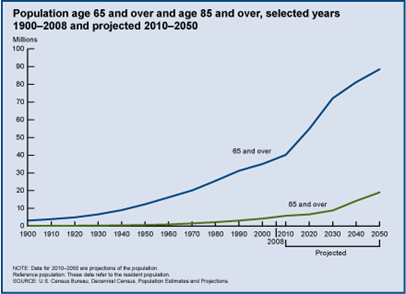Introduction
 Aging is both inevitable and universal. As people age they change in a myriad of ways - biologically, psychologically and physiologically. Data from the US Census Bureau show that in 2008 there were 39 million Americans 65 years of age and older, a dramatic increase from the 3 million in 1900. In addition, as shown in the graph on the right, the populations aged 65 and over and 85 will increase dramatically in coming years, and these increases will be accompanied by a large increase in the number of people suffering from age-related diseases, such as osteoporosis and Alzheimer's disease.
Aging is both inevitable and universal. As people age they change in a myriad of ways - biologically, psychologically and physiologically. Data from the US Census Bureau show that in 2008 there were 39 million Americans 65 years of age and older, a dramatic increase from the 3 million in 1900. In addition, as shown in the graph on the right, the populations aged 65 and over and 85 will increase dramatically in coming years, and these increases will be accompanied by a large increase in the number of people suffering from age-related diseases, such as osteoporosis and Alzheimer's disease.
Despite the progress decline in function associated with aging, many elderly individuals remain cognitively sharp and physically active. These people are generally considered the fortunate recipients of "good genes," although others cite a life-long healthy life style as the key to successful aging. The rapid grow of the elderly population makes it increasingly important to understand the aging process and to promote lifestyle choices that maximize not only longevity, but also the quality of life during aging.This module will summarize what is currently known about the biology of aging, major theories of aging, physical and cognitive effects of aging, and interventions that may diminish physical and cognitive decline.
Learning Objectives
- Explain the role that the p53 protein plays in cancer and aging
- Discuss the major theories of aging including
- Discuss the potential role of caloric restriction as a possible strategy to increase life expectancy
- Summarize the physiological changes that occur during the aging process
- Explain how diet and exercise influence the aging process